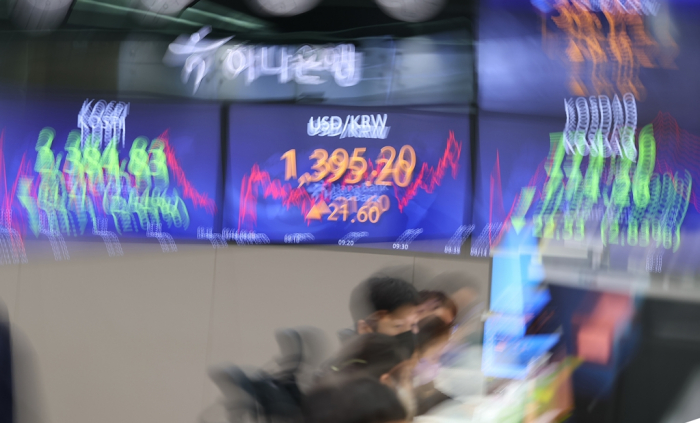The KED View
Was South Korea’s FX intervention too late?
The country needs to take stabilization steps, to include not only intervention but also slower overseas investments by pension funds
By Sep 21, 2022 (Gmt+09:00)
3
Min read
Most Read
LG Chem to sell water filter business to Glenwood PE for $692 million


Kyobo Life poised to buy Japan’s SBI Group-owned savings bank


KT&G eyes overseas M&A after rejecting activist fund's offer


StockX in merger talks with Naver’s online reseller Kream


Mirae Asset to be named Korea Post’s core real estate fund operator



The South Korean won on Sept. 14 opened 1.4% lower in the domestic currency session after shocking US inflation data rattled global financial markets.
The tumble prompted Vice Finance Minister Bang Ki-sun to convene an emergency meeting with key macroeconomic officials and financial authorities.
Bang warned against increased volatility in the currency market during the meeting, saying “we will closely watch financial and foreign exchange markets with extra caution while keeping an eye on global inflation and monetary policy normalization.”
Such a warning was not enough to stabilize the won. The South Korean unit lost as much as 1.6% to reach 1,395.5 per dollar -- its weakest level since the 2008-09 global financial crisis -- during domestic trade, inching close to the psychologically important 1,400 level.
That compared with the Japanese yen’s strength after Finance Minister Shunichi Suzuki stepped up the rhetoric to curb further depreciation in the currency, which hit a 24-year low versus the greenback.
"Yen moves have been quite rapid over the past few days," Suzuki had told reporters earlier. "If we were to step in, we will do so swiftly without any interruption."
In addition, the Bank of Japan conducted an exchange rate check with banks in apparent preparation for intervention, foreign media such as Reuters reported.
INTERVENTION TO KEEP WON STRONGER THAN 1,400 VS DOLLAR

The authorities were estimated to have spent more than $700 million on Sept. 15 when the won skidded further to as weak as 1,397.9 per the US currency. Despite the intervention, the South Korean currency ended local market trade down 0.2% at 1,393.7.
On the next day, they were suspected of dumping $2 billion as the local unit touched 1,399.0, its weakest point since March 31, 2009, showing their determination to keep the currency from breaking through the 1,400 level, traders said. That finally helped the currency close the domestic trade up 0.4% at 1,388.0.
A country often steps into the foreign exchange market to stabilize its currency when psychological factors increase its volatility, although its moves usually reflect economic fundamentals and capital flows.
But South Korea’s latest intervention was not conducted in a timely manner and official warnings were not strong enough to save the won.
They may not have needed to burn through as much of the foreign exchange reserves last week if they had taken appropriate actions on Sept. 14 when the impact of strong US inflation data had been well forecast.
A STITCH IN TIME SAVES NINE
South Korea did not take much action even as the won lost ground, underperforming other emerging Asian currencies such as the Indonesian rupiah and the Thai baht, after the US Federal Reserve raised its interest rates by 75 basis points (bps) in July.
The currency authorities have been relatively inactive in the market, saying the dollar is strong globally.
The won is expected to grow more volatile especially as the Fed is forecast to ramp up the target federal fund rate by at least 75 bps on Wednesday to a range of 3.00-3.25%, which is higher than the Bank of Korea’s benchmark interest rate of 2.50%.
The South Korean central bank, which has said it would allow such interest rate discounts, may spur speculative currency trading unless the authority takes appropriate measures to stabilize the won.
The BOK, along with the finance ministry and other authorities, needs to consider various steps including slower overseas investments by pension funds in addition to skilled intervention.
A stitch in time saves nine. A repeated failure in currency stabilization may cause authorities to lose the market's confidence, making the won a target of global speculators.
Write to Byung-Yun Yoo at yooby@hankyung.com
Jongwoo Cheon edited this article.
More to Read
-

-
 MarketsS.Korea may have spent over $700 mn to support ailing won
MarketsS.Korea may have spent over $700 mn to support ailing wonSep 15, 2022 (Gmt+09:00)
3 Min read -

-
 Central bankBOK delivers fourth straight rate hike as inflation persists
Central bankBOK delivers fourth straight rate hike as inflation persistsAug 25, 2022 (Gmt+09:00)
3 Min read
Comment 0
LOG IN


